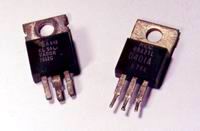In
1957, engineers working at the General Electric rectifyer research
laboratory developed a new type of type o diode basically comprising
a junction type PNPN made in a Silicon matrix originally denominated
as "Silicon Reverse-Blocking
 |
| Fig. 254 a - Several types of bidirectional
triode thyristors as known as "TRIACS". |
Triode Thyristor". In 1957, engineers
working at the General Electric rectifyer research laboratory developed
a new type of type o diode basically comprising a junction type
 |
| Fig. 254 - Several types of silicon controlled
rectifiers - SCR diodes |
PNPN made in a Silicon matrix originally denominated as "Silicon Reverse-Blocking
Triode Thyristor". Its operating principle consists to block the flow
of the forward current attempting to pass either way between the anode
and cathode under control of a gate electrode. Since such device normally
does not permit any appretiable working current to pass in reverse,
from the cathode to anode, it functions like a rectifier that can
be controlled and hence the name "Silicon Controlled Rectifier"Since
this type of semiconductor device can handle great deal of power without
reaching harmful temperatures, generally it is used as a rectifier
in power circuits. In the reality "Thyristor" is a generic term covering
a family of semiconductor devices such as "DIACS, "TRIACS", as well
as the four layers diodes. Fig 254
Other device developments stemmed from fundamental semicondictor research.
Perhaps the most classic was the development of the Tunnel diode.
|
|

